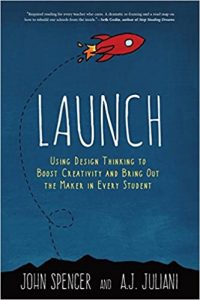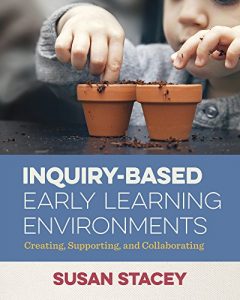Introduction, context and background:
I am the Teacher Librarian at a K-5 English language Elementary school of just over 300 students. The school is located in a semi-rural area south of town with most student coming from a higher socio-economic background. I was the Teacher Librarian from September 2017 until February 2019 at which point I went on maternity leave. In January, I returned to work as a grade 4/5 teacher but will be returning as the Teacher Librarian in the fall. For digital devices at the school, in January we received student devices, which are essentially two class sets of laptops, and dismantled the computer lab. These devices are stored in carts on wheels which make them easy to move to any area of the school where they are needed. In addition, we have 12 iPads that can be used. As a Teacher-Librarian, I believe it is my job to support student learning in multiple ways, with one of the main ways being teaching about and with digital technologies. This is an area of focus for improvement in my professional development and has been since starting as a Teacher Librarian. I have improved and learned a lot but still feel like I have a long way to go. The following are areas of focus in the area of digital technologies that I would still like to work on.
Areas and issues of personal interest:
- Digital Literacy and it’s connection to Visual Literacy.
- Digital Citizenship
- 24/7 Online Library Learning Commons website or blog.
- Creating a culture of inquiry-based teaching and learning in the school community.
- Developing lessons that can be carried out without the use of the library (if it cannot be used in the fall due to the COVID 19 pandemic).
Curricular connections: https://curriculum.gov.bc.ca/curriculum/adst/5/core
Applied Design, Skills, and Technologies 5
Applied Skills:
- Use materials, tools and technologies in a safe manner and with an awareness of the safety of others in both physical and digital environments.
Applied Technologies:
- Use familiar tools and technologies to extend their capabilities when completing a task.
- Choose appropriate technologies to use for specific tasks.
- Demonstrate a willingness to learn new technologies as needed.

Connection to digital technologies:
With the introduction of the student devices, we spent time teaching students how to use the devices with their personalized log-ins and how to save their work but we didn’t have the chance to teach digital citizenship. Therefore, because I was teaching grade 4/5 from January until June, I dealt with some instances resulting from these deficits when students were thrust into a digital world. So, I feel like I want to start in the fall, as soon as possible, with Digital Citizenship lessons; these can be done in the classroom or the library and will help in the proper use of digital technologies whatever or where ever that might be!
In relation to Digital Citizenship, I feel like students need to be taught Digital Literacy. I had noticed it before but it became more obvious during “online remote learning” that although students may use technology and digital devices frequently, their skills are limited to only a few that they use repeatedly. My beliefs were reinforced when reading Will Richardson’s book Why School?, especially the chapter “Our kids are illiterate”. Although I have heard other statements similar to what Richardson says; that future employers “…cited creativity and ‘managing the growing complexity of the world'” (2012, p. 144) more important that stored facts. However, in reading his book, it is the first time I have seen the “21st century literacies” from the NCTE and the fact “…that, if we applied those benchmarks, upward of 80 percent of students graduating from private, public, parochial, and home schools were illiterate” (2012, p. 189). The number is both surprising and it’s not considering my recent experience with online learning. It still remains that students need guidance to use digital technologies productively if only in the way of exposure to useful programs, software and apps. Additionally, students need more skills to comprehend and critically analyze what they are reading online. In this vein, I am interested in the connection between Digital Literacy and Visual Literacy and how becoming more visually literate can help students become more digitally literate.
As well, if I have a 24/7 online Library Learning Commons, students can access it at any time, from anywhere. I am hoping to make it interactive with activities and events that might be connected to the library. My biggest challenge here is to find a format that is approved by my district that I also find user friendly. In the past year I have been getting more comfortable with blogging so it might not feel like as much of a hurdle now.
Finally, before teaching at my current school, I taught at a school that had a very strong culture of inquiry starting in Kindergarten. At my current school, there is almost no inquiry-based teaching and learning. I have been trying to slowly integrate inquiry skill lessons through the library but now I have a bit of a set-back with my leave so I would like to start again in the fall. I find it to be quite a slow-go in this area but I believe it would be a huge pay-off if there was follow through from year to year. Students can use digital technologies in practicing inquiry skills and then choose an appropriate way of presenting their learning by using various digital tools. In addition, these are lessons that can be carried out in the classroom if need be. Students also need to have digital literacy skills in order to adequately answer their inquiry questions and have more options of presenting their learning.
Key words:
- Inquiry
- Digital Citizenship
- Digital Literacy
- Visual Literacy
- Online Library Learning Commons
- Remote learning
Context:
Students are in grades K-5, age ranging from 5 to 10 but I feel like I would focus most of my attention on the grade 4/5 (8-10 year olds) to begin and then work down. The administration at the school are very supportive and are also in line with my beliefs especially about starting digital citizenship lessons in the fall, we have already had discussions around this topic. The school is of a higher socio-economic standing with a very active PAC so access to technology is not lacking. The student devices and iPads can be used in the Library Learning Commons or the classroom and work with a variety of digital technologies.
Potential lesson and professional resources:
Common Sense Media has educational resources with lessons and videos for teaching digital literacy and digital citizenship. https://www.commonsense.org/education/.
As a government resource, the Keep Learning site
https://www.openschool.bc.ca/keeplearning/ offers and Online Safety section https://www2.gov.bc.ca/gov/content/erase/online-safety which also have links to videos.
A great resource that I would like to try and follow all the way through is Coding Quest which uses the Scratch program for students to create their own game as a way to present their learning of a inquiry topic. https://www.thelearningpartnership.ca/programs/coding-quest.
These are some professional literature picks that were suggested by our district professional development committee that I am interested in:
Launch: Using Design Thinking to Boost Creativity and Bring Out the Maker in Every Student by John Spencer and A.J. Juliani (grade level K-12)

Inquiry-Based Early Learning Environments: Creating, Supporting, and Collaborating by Susan Stacey (grade level K-3)

Conclusions (for now):
All of these ideas are what I would like to achieve in the next few years but it is mostly a question of what should take the priority at this point. Many of these issues and areas of interest can be interconnected and lead from one into another, so I just need to decide where to start!
References
Applied Design, Skills, and Technologies 5 | Building Student Success – BC’s New Curriculum. (2020). Retrieved 11 July 2020, from https://curriculum.gov.bc.ca/curriculum/adst/5/core
Free images. (2020). Question mark, answer, solution [Image]. Retrieved from https://pxhere.com/en/photo/1586349
Richardson, W. (2012). Why School?: How Education Must Change When Learning and Information Are Everywhere (Kindle Single) . TED Conferences. Kindle Edition.
Spencer, J. (2020). Launch book cover [Image]. Retrieved from https://www.amazon.ca/Launch-Design-Thinking-Creativity-Student/dp/0996989544
Stacey, S. (2020). Inquiry-Based Early Learning Environments: Creating, Supporting, and Collaborating [Image]. Retrieved from https://www.amazon.ca/dp/B078XK3X9X/ref=dp-kindle-redirect?_encoding=UTF8&btkr=1
Wallpaper Flare. (2020). HD wallpaper:Digital marketing – with copysack – dark version [Image]. Retrieved from https://www.wallpaperflare.com/digital-marketing-with-copyspace-dark-version-business-communication-wallpaper-agmyn

This is a strong first post. You are exploring important themes and asking good questions. I appreciate your narrative structure and personal connections. The topics you are exploring are important and immediately relevant. Excellent inclusion of learning from Why School as well as multimedia elements that enhanced your post.